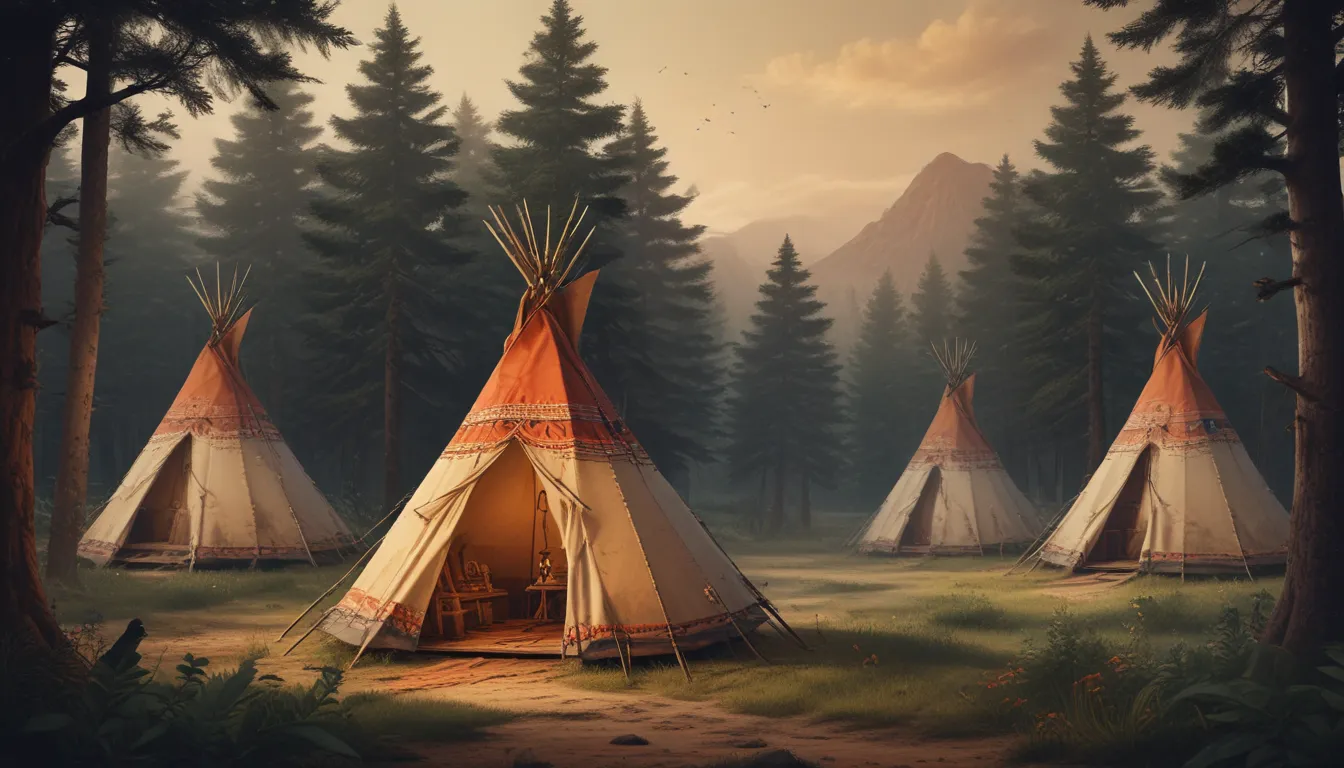The images in our articles may not match the content exactly. They are used to grab your attention, not to show the exact details in the text. The images complement the text but do not replace it.
Are you curious about the captivating world of teepees and their rich history? Prepare to be amazed! Teepees, those iconic cone-shaped tents, have served as more than mere shelters for the indigenous peoples of the Great Plains. They embody resilience, adaptability, and a profound connection between humans and nature. From their ingenious design that withstands the harshest weather to the intricate details that narrate tales of generations, teepees harbor secrets waiting to be discovered.
Did you know that constructing a teepee is both an art and a science, reflecting the cultural richness of its creators? Let’s embark on a journey through the enthralling realm of teepees, where every stitch and pole unravels a story of survival, community, and harmony with the earth. Get ready to delve into these 32 best teepee facts!
Unveiling the Essence of Teepees
What exactly is a teepee? A teepee, also spelled tipi, is a cone-shaped tent traditionally crafted from animal skins draped over wooden poles. Originating with the Indigenous peoples of the Great Plains in North America, teepees were ingeniously designed for portability and resilience, making them ideal for nomadic lifestyles. Their unique structure enabled them to brave the severe conditions of the plains, enduring scorching summers and freezing winters alike.
The Art of Early Teepee Construction
- Materials: Early teepees were predominantly crafted using buffalo hides sewn together with sinew. These hides were then stretched over a framework of long, flexible wooden poles, typically sourced from trees like lodgepole pine for their straightness.
- Design: A key feature of teepee design was the smoke flap at the apex, adjustable to manage ventilation and allow smoke from the central fire to escape, ensuring a comfortable interior environment.
- Portability: For nomadic tribes, the swift assembly and disassembly of their dwellings were essential. A typical teepee could be dismantled and packed away within minutes, enabling families to follow the migratory patterns of buffalo herds.
Cultural Significance of Teepees
- Spiritual Meaning: Teepees held profound spiritual significance for many tribes, symbolizing the circle of life with the door always facing east to greet the sunrise.
- Decorations: Families adorned their teepees with symbols and patterns reflecting their achievements, beliefs, and social status, creating deeply personal and generational decorations.
Modern Applications of Teepees
- Camping and Glamping: Teepees have found new life in camping and glamping, offering spacious interiors and a distinctive aesthetic for outdoor enthusiasts seeking an alternative to traditional tents.
- Educational Tools: Schools and cultural institutions utilize teepees as educational tools to impart knowledge about the history and culture of Native American tribes, providing a hands-on learning experience.
- Events and Festivals: Teepees are a common sight at festivals and outdoor events, serving as shelter and visually striking backdrops that honor their cultural roots.
Tackling Construction and Maintenance Challenges
- Weather Resistance: While traditional teepees were designed to withstand various weather conditions, preserving the integrity of materials, especially animal hides, demanded regular care and attention.
- Modern Materials: Present-day teepees often utilize contemporary materials like canvas, offering enhanced durability and ease of maintenance compared to traditional animal skins but potentially sacrificing some authentic attributes.
Embracing Teepee Living in the 21st Century
- Sustainability: With a rising interest in sustainable and minimalistic living, some individuals have embraced teepees as low-impact housing solutions, embracing the simplicity and connection to nature they offer.
- Cultural Respect: While teepees are cherished for their beauty and functionality, it’s crucial to approach their utilization with respect for their cultural significance and origins, honoring the rich heritage and traditions of the Indigenous peoples.
- Community and Connection: Those opting to reside in or utilize teepees today often experience a sense of community and a deeper connection to the environment, echoing the communal and harmonious lifestyle of the teepee’s original inhabitants.
- Adaptation and Innovation: Modern teepee enthusiasts often integrate contemporary amenities into their structures, such as solar panels for electricity or insulated liners for added warmth, demonstrating the adaptability and enduring appeal of this ancient abode.
- Educational Programs: Various organizations and tribal communities offer workshops and programs focused on teaching the art of teepee construction, maintenance, and the cultural heritage they embody, ensuring the preservation of these skills and knowledge for future generations.
Indulging in Teepee Lore
Delving into the realm of teepees has been an enlightening voyage, unveiling not just their functionality but also their cultural significance. These structures, beyond being shelters, serve as testaments to the ingenuity and adaptability of the Indigenous peoples of the Great Plains. Teepees symbolize a harmonious synchronization with nature, engineered to withstand environmental elements while furnishing a mobile abode for families.
Their construction, from material selection to decorative artistry, signifies a profound reverence for the environment and a rich cultural legacy. Through our exploration of these 32 captivating facts, it becomes evident that teepees are not mere historical relics but living emblems of resilience, community, and identity. They remind us of the wisdom in simplicity and the strength in unity, teachings as pertinent today as they were centuries ago.
Frequently Asked Questions
What exactly is a teepee?
A teepee, often spelled tipi, is a cone-shaped tent traditionally made of animal skins upon wooden poles. Native American tribes, particularly those of the Great Plains, used them as movable homes due to their easy assembly and disassembly.
How did Native Americans use teepees?
Native Americans utilized teepees as living spaces that could be quickly erected and taken down, making them perfect for nomadic lifestyles. These structures provided shelter from the elements, warmth during cold nights, and a communal area for families.
Can you still find teepees today?
Yes, teepees are still around! They’re used in cultural ceremonies, educational settings, and even as a unique camping experience for those looking to connect with nature and history.
What materials were originally used to make teepees?
Originally, teepees were crafted from buffalo hides stretched over long wooden poles. Today, more modern materials like canvas are common, but the traditional design remains largely unchanged.
How long does it take to set up a teepee?
Setting up a teepee can vary in time, but with practice, it can be done relatively quickly. A small group can erect a standard-sized teepee in about an hour, making it an efficient dwelling for mobile tribes.
Are teepees considered sacred?
For many Native American tribes, teepees hold significant cultural and spiritual importance. They are not just shelters but symbols of the universe, designed to live in harmony with nature and the spiritual world.
What’s the difference between a teepee and a wigwam?
While both are types of indigenous shelters, there’s a key difference: teepees are cone-shaped and designed to be moved easily, whereas wigwams are dome-shaped and meant to be more permanent structures.
How do teepees withstand harsh weather?
Thanks to their conical shape and sturdy construction, teepees are remarkably resilient against harsh weather, including strong winds and heavy snow. The slope of the sides allows rain and snow to slide off, while the smoke flaps at the top can be adjusted to control ventilation and temperature.
Parting Thoughts
As we bid farewell to this immersive exploration of teepee facts, we reflect on the enduring allure of these iconic structures. Teepees transcend mere tents; they embody a cultural legacy, a testament to centuries of wisdom and craft. Through their resilience, adaptability, and profound connection to nature, teepees serve as reminders of the harmonious balance we can achieve with our surroundings.
Whether used for shelter, education, or cultural celebration, teepees continue to inspire and enlighten, weaving a narrative of survival, community, and identity. Let the spirit of teepees guide us as we navigate modern challenges with reverence for the timeless lessons they impart.






